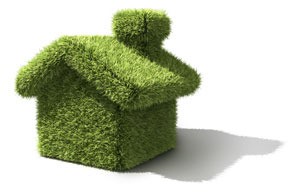
Part of home maintenance is maintaining the exterior. As projects come up (and they always do), why not use the opportunity to go green? Having an eco-friendly exterior does not mean you need $10,000 worth of solar panels either. Over time, much smaller changes can add up to big savings-for you and for the environment.
1. Weatherize old widows: If your windows are in good overall shape, replacing them isn't necessary. Studies have shown that older windows can perform just as well as their vinyl replacements as long as they are in good repair and properly sealed to prevent excessive air exchange. Caulk the exterior trim of your windows and repair cracked glazing or damaged putty around the glass, and while you're at it, check for air leaks around skylights. Then pat yourself of the back for reducing the demand for vinyl, thereby reducing the non-biodegradable waste and toxic byproducts that result from its production.
2. Make smart paint choices: Recently, a small number of low VOC, eco-friendly exterior paints have come onto the market. Unlike their high-performing interior counterparts, the jury is still out (at least among professional painters) on whether or not the exterior versions can withstand long-term exposure to the elements. Eco-friendly exterior paints also come at a higher cost ($50-$60 dollars a gallon), so make sure to do your research before buying.
3. Insulate your crawl space: Most people insulate their attics and basements, but they tend to overlook the heat lost by their crawl space. There are many eco-friendly insulation options available, but the type of insulation you use will depend on several factors: climate and recommended R-value, the direction your house faces, drainage, ventilation, and local building codes. Check with your local building safety office and local home center for more information.
4. Seal leaks and stop drafts: Keep exterior doors airtight with weather-stripping. Install chimney rain covers, and keep fireplace dampers closed when not in use. Seal dryer vent leaks by using covers that open only when your dryer is in use. Seal and insulate around water pipes, cable connections, and anywhere the exterior of your home has been penetrated with pipes or wiring.
5. Roof responsibly: If your budget allows, roofing materials made of metal, ceramic tile, or slate are the greenest choices. Traditional asphalt shingles, although not the best choice for the environment (lack of durability, difficult to recycle), are still the most affordable. Not all asphalt is created equal, though. Organic-based asphalt shingles (made from recycled natural materials like paper, felt, and wood fibers) are a greener choice then their fiberglass-based counterparts. Higher asphalt content also gives them greater weight, which makes them more durable and resistant to damage. When replacing roofing with asphalt, install light-colored shingles to reflect heat.
6. Landscape strategically: Trees and shrubs cannot only increase your property value, but when strategically planted they also lower the demands on your heating and cooling systems. Plant a row of evergreen trees on the north and east sides of your house to shelter you from winter winds. Plant deciduous trees on the south side of your house to shield your home from the summer sun. In the winter, their dropped leaves will allow the sun to penetrate. Low-growing shrubs in front of an air conditioning unit cast a cool shadow.
7. Open your windows: In the spring and summer, turn off your air conditioner. Instead, create cross ventilation using open windows and cool air down with dehumidifiers. In the case of many older homes, the original layout was often designed with cross ventilation in mind.
8. Select the greenest products: When greening the exterior of your home, select the greenest products available. How do you know if a product is green? The answer depends on your location, your climate, your project, and what materials are available locally. In general, if a product saves water or energy; replaces toxics chemicals with healthier alternatives; conserves resources; or reduces, reuses or recycles waste; it's probably green.
Finally, invest in an energy audit. Call your local utility company (or visit http://hes.lbl.gov) to schedule a home energy audit. They can pinpoint problem areas and make recommendations for improving your home's efficiency.

About The Author: Ellen Brown is an environmental writer and photographer and the owner of Sustainable Media, an environmental media company that specializes in helping businesses and organizations promote eco-friendly products and services. Contact her on the web at http://www.sustainable-media.com
Add your voice! Click below to comment. ThriftyFun is powered by your wisdom!
Great tips but most people probably won't open up the post with that house as an example. I opened it up to see if there was another house photo listed.
Add your voice! Click below to comment. ThriftyFun is powered by your wisdom!